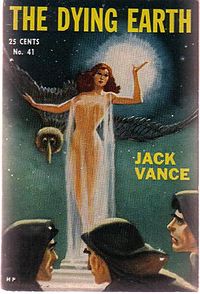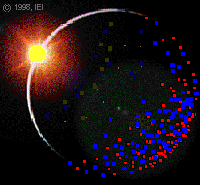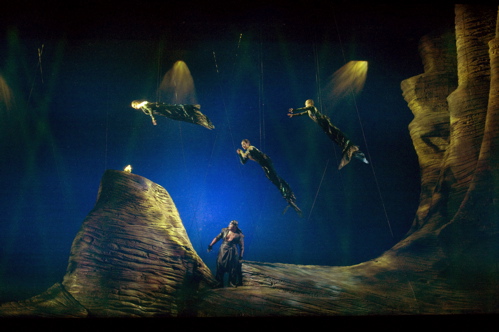
Dungeons & Databases
My e-pal Elizabeth Hand recently mentioned that she was rereading Jack Vance’s The Dying Earth and was going to contribute something to a forthcoming volume about this masterwork of modern fantasy. Since I’ve read other Vance books and liked them, and was hungry for some juicy imaginal fare, I decided to finally read it myself. I dug out an old crumbly paperback with yellow pages, tiny print, and a thoroughly cracked spine. Though I don’t enjoy reading these sort of volumes much anymore, I thought I’d resist buying a larger format reading copy in faint homage to all the used paperbacks I read when I first dove into the genre as a teenager. It turned out that when I turned the pages they tended to separate from the glue in the spine, meaning that, as in some bottle-imp tale, my first read would be, of near necessity, the final read, at least as far as this particular volume is concerned.
This literary death-in-life seemed appropriate for The Dying Earth, which is crepuscular through and through. With this book, which was first published in 1950, Vance more or less invented an arcane but spiritually significant subgenre in the annals of modern fantasy. As with much sword’n’sorcery, Vance’s world is characterized by occult neo-medievalism, featuring necromancers, jeweled scabbards, mysterious woods, and wan maidens a plenty. Vance’s brilliant twist is to set this world in the far future of our earth, a dwindled time where our advanced technological civilization has collapsed. Human culture has slipped back into serfdom and decadence, and the walls between Faerie and the object of science have began to warp again. So though it reads like fantasy, the dying earth scenario—used frequently by Vance and other subsequent writers, most notably Gene Wolf in his matchless multivolume Book of the New Sun—can be seen as a species of science fiction.
Part of the attraction of fantasy is its nostalgic charge, a romantic hankering for a world of enchantment that no more defines our sere and depleted modern world. That is why quasi-medievalism holds sway over the genre—the Middle Ages being the last era in the history of the West whose literature and iconic lore remains as exotic and peculiar as it is familiar. Faced with medieval culture, with grail lore or stained glass, we can sense how narrative and images can glue an entire organic world together despite its unscientific basis. This is the recipe for fantasy. But because fantasy is also a thoroughly modern genre, it inevitably shows its cracks—since even those rare writers who can successfully create deeply enchanting “Secondary Worlds” rub against the starkly disenchanted reality within which they live their everyday lives. When fantasy is not simply wish fulfillment or youthful adventure, it lends itself, therefore, to irony and decadence—from the hip perversity of Beckford’s Vathek through the wry urbanity of Dunsany’s Book of Wonder through to the Baudelairean misanthropy of Clark Ashton Smith and the stifling architectures of Mervyn Peake.
In The Dying Earth, this air of lassitude and rot has an objective correlative: the earth is dying because the sun has finally reached the end of the line. Just as fantasy itself is an essentially belated mode, its world is belated as well, and an endless vermilion twilight holds the land and its sunken spirits. Here Vance unfolds a loosely linked series of tales centered on sorcerers, heroes, and biologically engineered freaks. With a tone lodged somewhere between Smith and Michael Moorcock, Vance restrains his irony through a pulp desire to please. While he can certainly spy the Meaningless Void of modernity from atop his crenellated castle of prose—one of his characters, the botched vat-babe T’sais, finds that existence itself is an evil—he is a friendly and generous stylist. In an early story, one character describes a blasphemous black mass, and his words apply to most of the characters and environments Vance describes: “Even here is beauty…Weird and grotesque, but a sight to enchant the mind.” Vance’s descriptions of nature are particularly lush and plaintive, and the proper names he invents are at once silly and stirring: the Cape of Sad Remembrance, the Signs of the Aumoklopelastianic Cabal, a maiden named Shierl, whose name echoes the pulpster MP Shiel, whose Purple Cloud also names the drift of heroic prose.
This echo seems apt, for it Vance ironizes anything, it is not the vanity of human desire so much as the artifice of fantasy writing itself—a kind of writing that simultaneously invokes imaginative power while exploiting the mechanical rhetoric of the genre. Here Vance is, in the final and greatest story in the volume, reflecting on his own prose, as if the words and the images were equally marked with Maxfield Parrish purple:
The sun, old and red as an autumn pomegranate, wallowed in the south-west; the light across the plain was dim and watery; the mountains presented a curiously artificial aspect, like a tableau planned for the effect of eerie desolation.
It is this blend of enchantment and self-consciousness technique/technology that Vance so brilliantly embodies in the dying earth scenario, when even the strongest sorcerers are Johnny-come-latelys, belated hoarders of commodified spells—like Phandaal’s Gyrator and the Excellent Prismatic Spray—that were created by earlier and greater wizards. (Anyone who has ever played D&D or its descendant RPGs will be amazed at how similarly Vance’s spells are fetishized, wielded, traded, and spent.)
This old magic is contrasted with the “impersonal magic” of future technology, like the automated buildings and flying cars that the sexy renegade Ulan Dhor encounters in the desolate city of Ampridatvir. And in the final story, “Guyal of Sfere,” the eponymous hero hungers like none of his peers for knowledge, a deep curiosity—that we are clearly supposed to recognize as our own—that leads him to seek out the fabled Museum of Man in the far northern wastes. Here, he discovers, the sum of human knowledge is stored in computer-like “banks” in a ruined repository in a dead city. It is like Shelley’s “Ozymandias,” only it is human knowledge rather than power that crumbles. But unlike power, knowledge does not quite disappear, and in the end Vance escapes the clinging rot of planetary dacay towards the cosmic promise of science fiction, to an offworld future freed of fantastic dregs: “Attend: the stars are bright, the stars are fair; the banks know blessed magic to fleet you to youthful climes.”




